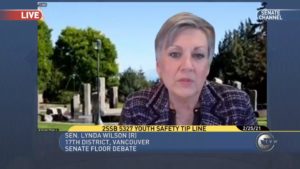Hello Friends and Neighbors,
As the halfway point of our scheduled 105-day session approaches, we’re spending our days on the “floor” of the Senate chamber debating and voting on legislation that cleared the necessary committee hurdles.
The bills we’ve passed this week have been sent over to the House of Representatives, and the members of the House are doing the same in return. After March 9 we’ll be through with the first round of “floor action,” then the Senate policy committees and budget committees will reconvene to consider bills passed by the House.

This week the Senate unanimously approved legislation to create a confidential tip line for students to report potential self-harm or criminal activities directed at schools, students or school employees. It’s a good idea anyway, but the effect of the pandemic on our students makes it all the more important.
A new effort to get our students back into classrooms
I knew our state is behind in reopening classrooms, but only this week did I learn Washington is behind nearly every other state in providing in-person instruction. According to an online school-opening tracker, our state ranks 47th in the nation, with just over 20 percent of students receiving in-person instruction.
This is unacceptable! We know from the past year that being in classrooms is best for our children. The longer they’re forced to receive most or all instruction remotely, the more they suffer academically, socially and emotionally.
Also, we’re hearing the word “equity” a lot this session – but the school closures are the equity issue of our time. The obvious shortcomings of remote instruction are being felt disproportionately by rural and lower-income families and communities of color. What’s happening is also unraveling the promise of equity made a few years ago, when the Legislature overhauled the K-12 funding system so a child’s educational opportunities wouldn’t depend on living in a certain ZIP code. And this doesn’t even take into account the additional billions of dollars that have been invested in public schools in recent years!
Our state government has a constitutional duty to provide for the education of Washington children. They clearly are not receiving the quality instruction to which they’re entitled. I’m also terrified that any day now I will hear from another local family whose teen child has been driven to suicide by the isolation caused by school closures. Members of the Senate health-care committee were told recently that more Washington teens have died of suicide during this pandemic than from the virus itself. Sadly, I believe it.
Coincidentally, the discouraging news about our state’s students came a day after I introduced Senate Bill 5464. Under my legislation, schools may not be closed for in-person learning beyond 10 consecutive school days without the approval of the governor, the secretary of health, or a local health officer.
The point of SB 5464 is to limit the number of people who have the ability to stand between students and their classrooms. It’s good to see the governor is no longer in the way – he’s moved significantly toward the position we’ve been taking for months, to the point of visiting schools and publicly stating that students can return to classrooms safely. Now school district boards need to reach the same conclusion and get reopening plans in place.
No progress toward next phase of reopening – because there’s no ‘next phase’ yet
It’s been seven weeks since Governor Inslee announced his “Healthy Washington – Roadmap to Recovery” plan. While I was disappointed that it kept an important sector of our economy in lockdown, at least the affected employers could see what would be allowed in Phase 2 once regions of our state were able to advance.
As of Valentine’s Day, all regions were in Phase 2. The governor should have been forthcoming then about what was next. But only yesterday did we learn the Inslee administration has yet to figure out what a Phase 3 would look like, and how our state’s regions would get there. The governor says it will take several more weeks to “gather information” before deciding what’s next. What were he and his staff doing for the past seven weeks? What more do they need to know?
It’s no consolation that the governor declared none of the regions in Phase 2 is subject to reverting to Phase 1. Instead, let’s keep in mind that four months ago, the businesses that are now stuck in Phase 2 with its 25% occupancy limit were able to have up to 50% occupancy. I’ve met regularly with Clark County restaurant owners for many months, and they need to be at 50% — so Phase 3 should allow for at least that much!
It amazes me that the governor remains so distrustful of some employers while others are allowed to be fully open with little if any government interference. I’d encourage him to publicly visit some of the businesses affected by his restrictions. I want him to see for himself how they are prepared to take all the precautions necessary to protect their customers and employees, and safely move to at least a 50% occupancy level. I trust they are!
Vaccination fairness for Clark County!
Talk about timing: On Wednesday I and 9 other area legislators sent a letter to the Secretary of Health, expressing our bipartisan concern that his agency is sending Clark County a disproportionately low number of COVID-19 vaccines compared to other large counties.
Later Wednesday, by happy coincidence, I received an email from a regional Walmart official alerting me that starting the next day (Feb. 25), seven of the company’s stores in Clark County would be administering the vaccines!
The Walmart doses are above and beyond what the state is allocated, and are sure to help lift the numbers here in our county. Click here for a list of national and independent pharmacies that are, like Walmart, collaborating directly with the federal government to increase vaccine access.
Tomorrow, our bipartisan Clark County legislative delegation will be meeting with the governor’s office and officials from the Department of Health to get to the bottom of this and ensure we get back on track with getting Clark County our fair share of vaccine doses!
We should discuss policing reform, but in a balanced way
The added workload that goes with holding the top Republican position on the Senate Ways and Means Committee caused me to step away from serving on the Senate Law and Justice Committee. Therefore, my first chance to vote on Senate Bill 5051 didn’t come until late last night, after a debate that lasted close to four hours.
This bill would make far-reaching changes aimed at our state’s law-enforcement community. The more significant and contentious aspects have to do with the authority of the state Criminal Justice Training Commission to administer standards and processes for certification, suspension, and decertification of peace officers and corrections officers.
Policing was put under a microscope like never before this past year, and I share the outrage people felt at seeing unacceptable behavior by law-enforcement officers. There should be accountability, but SB 5051 seems to tip the CJTC away from a focus on training – its original role – and too far toward giving an expanded and rearranged commission an undue level of control over the discipline and the very employment of law-enforcement officers.
We’re just two years out from the passage of Initiative 940, which changed state law about the police use of deadly force. In that sense this bill also seems premature.
It isn’t easy to find people willing to put on a badge and take an oath that obligates them to put their lives on the line. I suspect it’s even harder now, after the events of 2020. I worry that SB 5051 doesn’t reflect the priorities of all of Washington, and wouldn’t help communities across our state to keep the peace and protect the rights of their residents.
All but two of the 39 amendments proposed came from Republicans. I thought mine was benign – it had to do with limiting the commission’s disciplinary powers in the event that a local disciplinary action was overturned on appeal or through arbitration. But it was rejected, as were all but one Republican amendment. That lack of input was reflected in the 26-19 final vote on the bill.
Introducing ‘Rational Steps Toward a Better Washington’
Do you remember how the air quality around Clark County was rated “very unhealthy/hazardous” for more than a week in 2020, because of wildfire smoke? That’s just one of the reasons I made a point of including funding in our Senate Republican budget proposal for work to improve the health of Washington forests.
For a fuller look at this part of our budget, click here or on the image to read the first edition of my budget-based policy paper: Rational Steps Toward a Better Washington. Let me know what you think!










